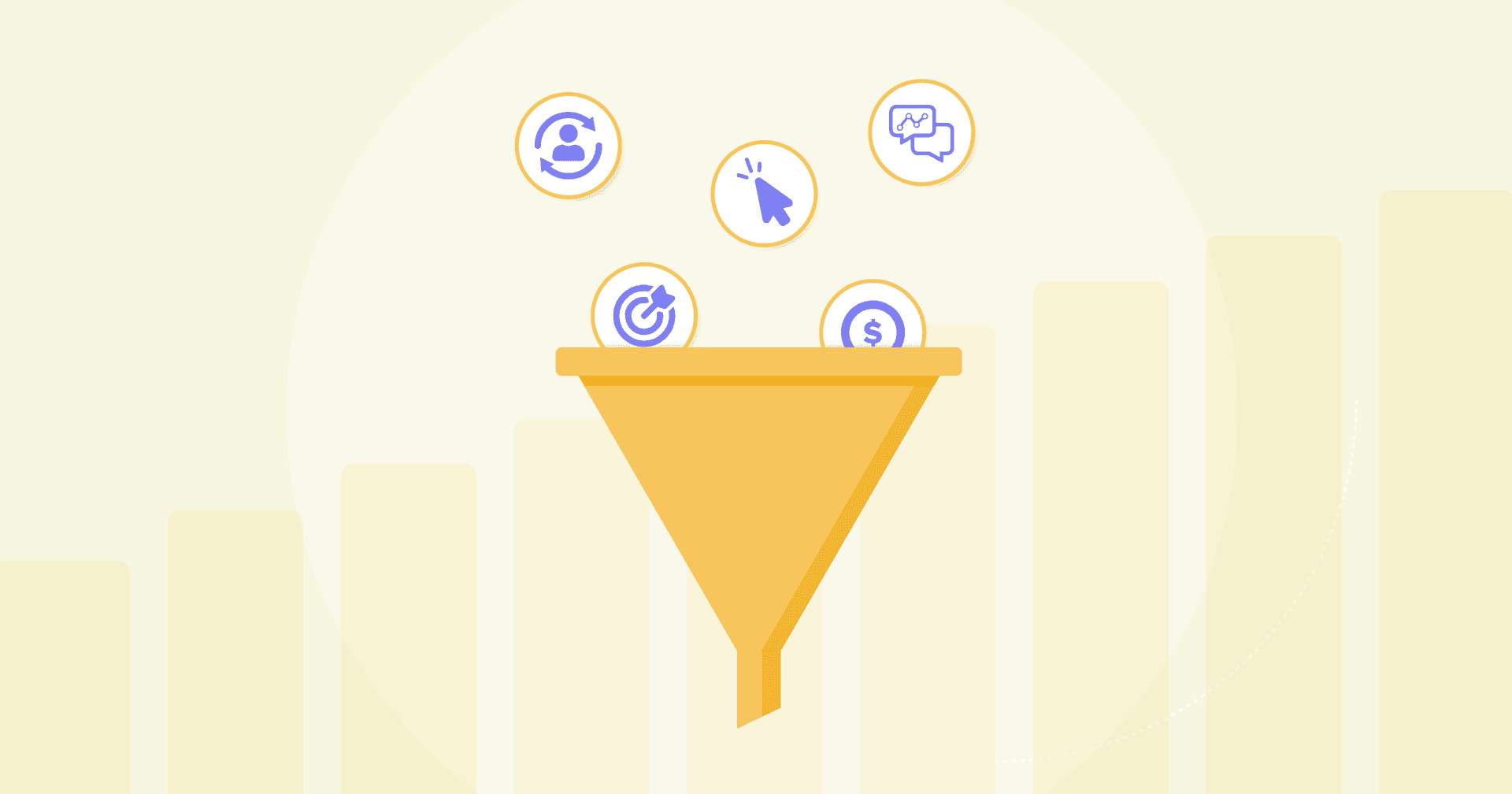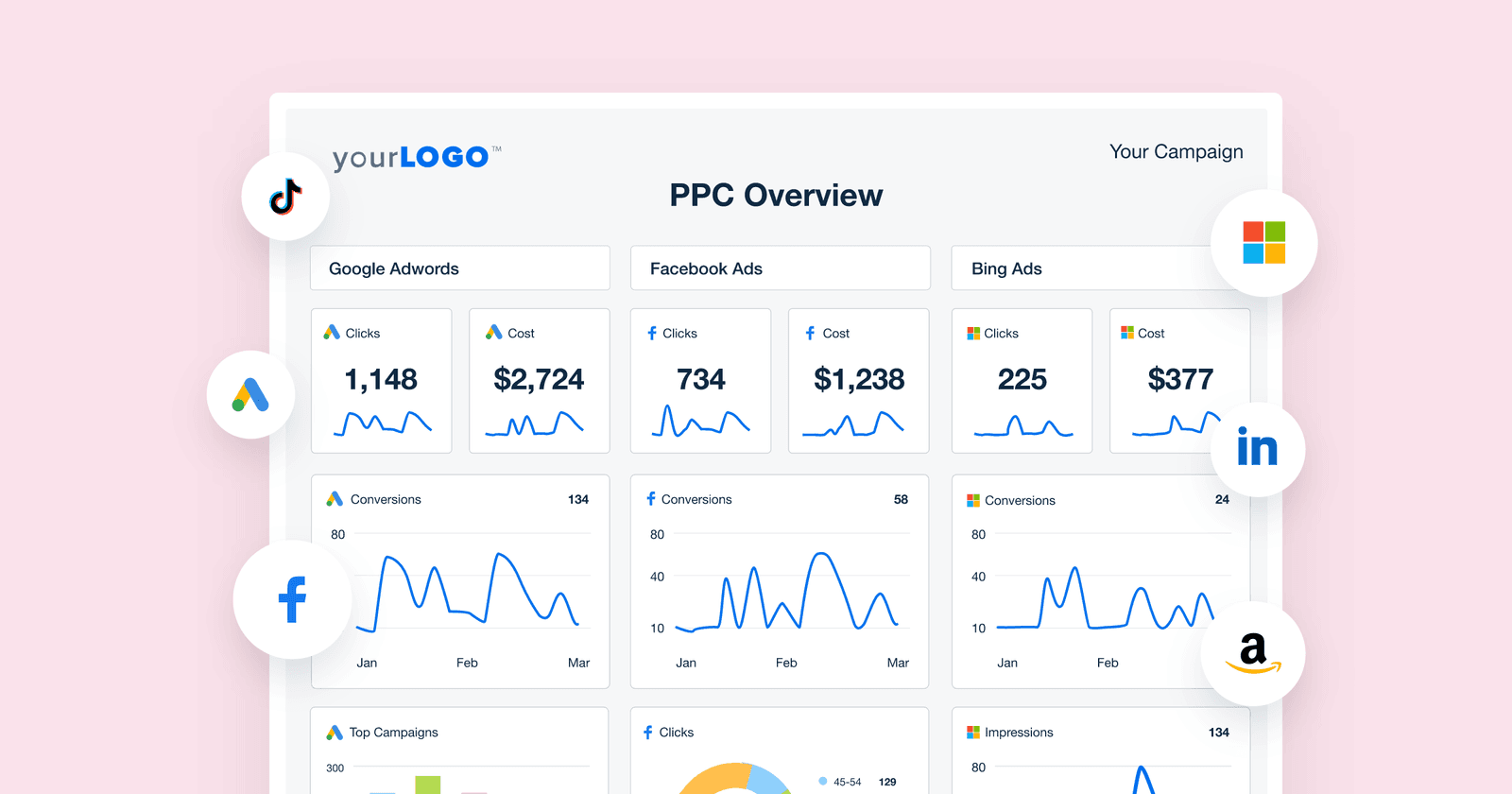
QUICK SUMMARY:
Tracking conversion rates involves calculating the percentage of visitors who complete desired actions, directly influencing a business’s marketing success. This guide explains how effective monitoring and analysis of conversion rates are necessary for enhancing client campaigns and overall agency performance, providing strategies for improving conversion metrics and reporting.
You’ve landed a brand new client, launched a PPC campaign, and continuously checked back in on results… only to find a worrisome trend: their ROI isn’t hitting the mark.
You dive into your campaign dashboard to try and figure out the problem. Starting on opposite ends of the funnel, you dig into the numbers. The audience looks good and impressions are strong.
Ah-ha. There’s the culprit. There’s a noticeable dip in the funnel when it comes to PPC ad clicks. The leads just aren’t converting, so that’s lowering campaign ROI. Prospects are getting lost on the other side of the wall. After some quick A/B testing, you tweak the messaging and the CTA in the ads. Over the next few days, the numbers start trending upward again as more new customers click on the ads, leading them to the campaign landing page.
That’s the power of conversion. Getting customers to take that leap to drive campaign success one click at a time. And for marketing agencies, conversions are the magic ingredient that will cause new clients to sign on for the long-term.
You compile the notes of your adjustments as annotations and connect them to the applicable metrics in the client report. After hitting send, your client sends you a glowing reply:
Thank you for addressing and fixing this issue so fast. Can’t wait to see what comes next!
Today, we’re sharing how consistent and accurate conversion rate tracking, analysis, and reporting will transform your customer retention rate and help your agency to scale. Let’s dive in.
Read on To Learn About
What Is Conversion Rate?
A conversion is a consumer action that moves a visitor towards fulfilling a business’ sales or marketing goal. And the conversation rate is simply the percentage of visitors completing the desired action.
Common conversion goals include:
Making a purchase on an ecommerce site or adding an item to cart.
Engaging with a website (e.g., time spent on page or number of landing page visitors).
Signing up for a newsletter or creating an account.
Downloading an asset such as an eBook or guide.
Clicking on an ad in Google search results.
Capturing leads through forms, chat or calendar bookings.
Micro and Macro Conversions
A potential customer may complete numerous actions in a single visit, so it’s helpful to break these actions down into macro conversions and their component micro conversions. A macro conversion is your client’s primary goal—whether that’s selling a product or funneling calls to their sales department. A micro conversion is a smaller step that leads down the road to that main action. In these examples, it could be adding a product to their cart or requesting a quote.
Choosing what specific macro and micro conversions to track really depends on the nature of your client’s business and the campaign. Choosing the most relevant goals for a PPC campaign will look very different from a social media awareness campaign. Overall, apply conversion tracking to any campaign that involves clickable links.
Why Is Tracking Conversion Rates Important for Agencies?
There are countless metrics that agencies should be tracking for clients. But among them, conversion rate stands out as a shining north star. Here’s why:
Prove You’re Delivering on ROI
Tracking conversion rates demonstrates that not only are you reaching your client’s target audience, but that your campaigns are generating results to grow their business. It puts quantifiable numbers to the success of your work.
Determine Relevant Budget Allocation
Direct funds to the most effective streams by comparing conversion rates across channels to identify the highest-performing strategies.
Identify Improvement Opportunities
Conversion optimization improves campaign performance over time as you identify and test different approaches. Comparing more successful campaigns with lower converting ones yields repeatable growth strategies and targeted improvements to proactively present to clients, to position your agency as their go-to expert and problem-solver.
How To Track Conversion Rates
When it comes to client satisfaction, it’s not enough to check in on results here and there, inconsistently. The key to optimization and success is continuously monitoring results in real time. So–how is that done? Let’s take a look.
Defining Conversion Goals
As discussed earlier, the first step is to define what a conversion means for your client—whether that’s generating leads, completed sales, or growing an email newsletter list.
A great way to establish clear conversion goals that are tailored to your client’s needs is by using the MASTER framework. The MASTER acronym stands for Measurable, Achievable, Specific, Transforming, Evolving, and Relevant. It’s a flexible and adaptable way to track primary and secondary conversion goals across campaigns, providing a clear roadmap to achieve objectives and enhance team communication.
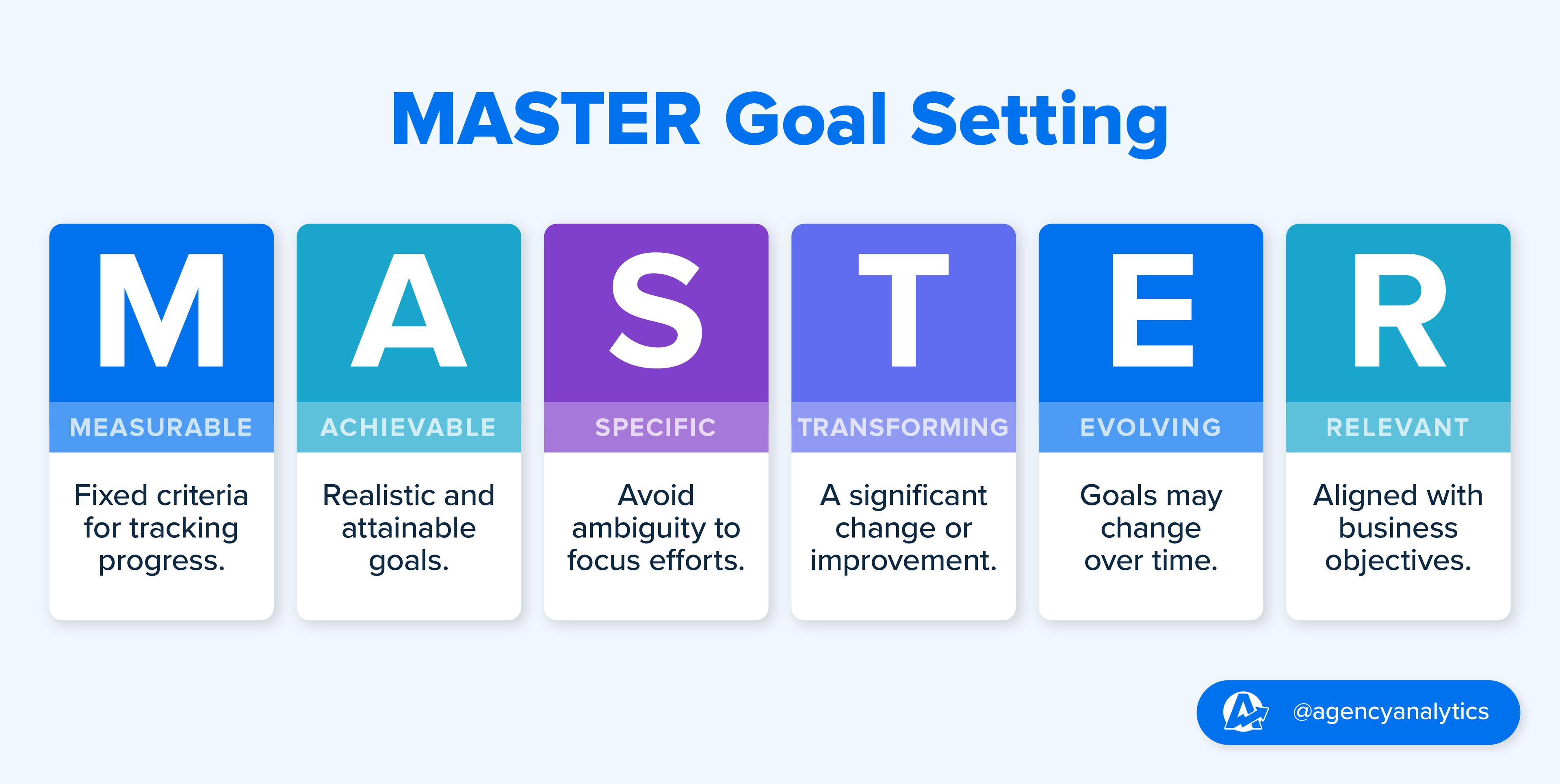
Locating Conversion Data Sources
Next, measure conversion data using the digital platforms relevant to the goal. This might include:
CallTrackingMetrics for inbound phone calls.
Mailchimp for email subscribers.
Google Ads for PPC campaigns.
Shopify for ecommerce sales.
Because many conversion metrics measure results at a channel or source level, the raw information should be segmented or filtered to hone in on the selected reporting metrics.
Some common segmentations are:
By conversion type
By source or channel
By page, action or event in a session
By campaign
The bad news is that manually compiling data from multiple sources is time-consuming and prone to errors. The solution? AgencyAnalytics.
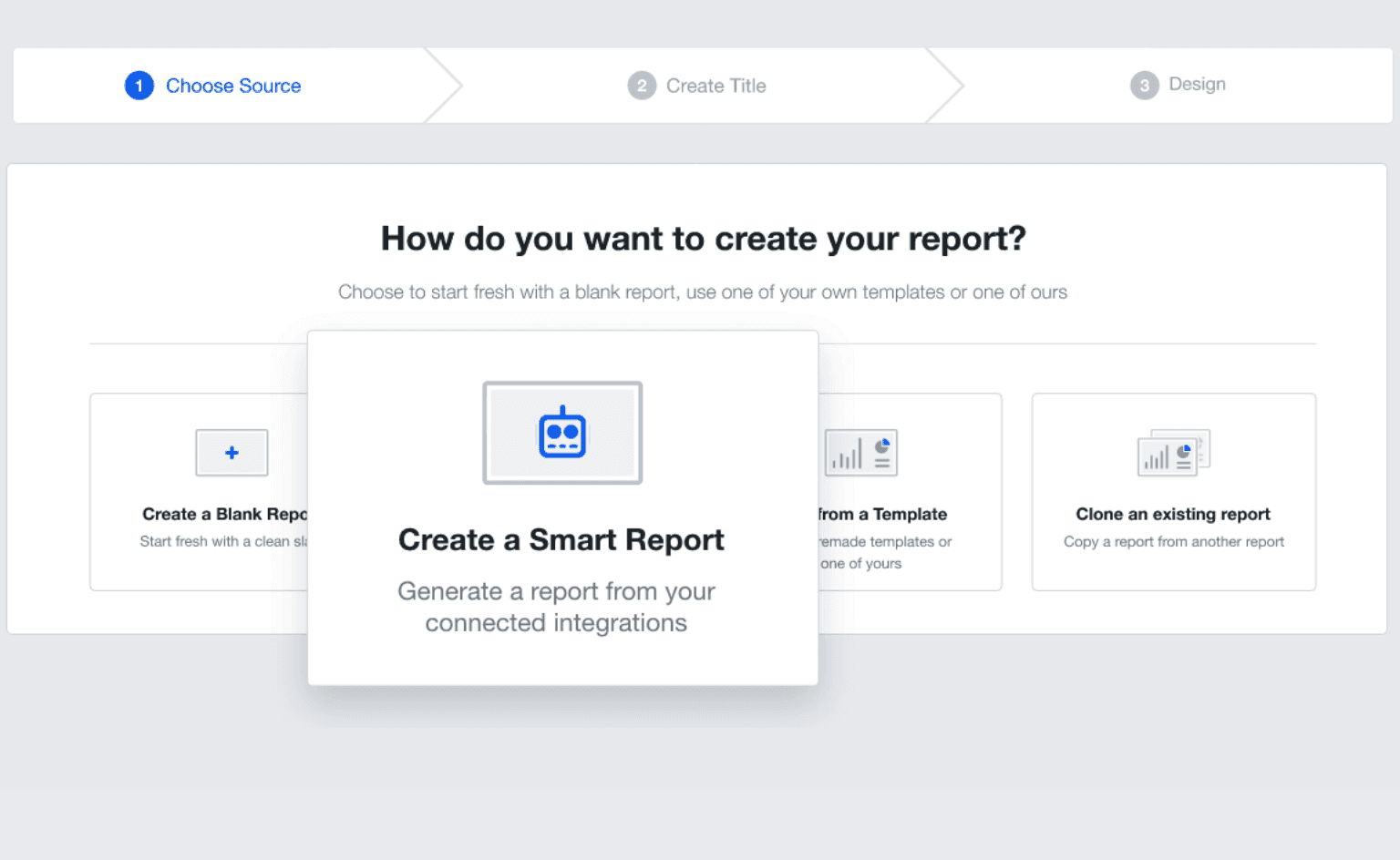
Connect to client conversion data and compile insights from more than 80 marketing integrations in 11 seconds flat, using the Smart Reports feature. Build your first report today by signing up for a free 14-day trial.
By working with a solution like AgencyAnalytics, your agency will consistently monitor key data points, and even automate reporting to streamline workflows… but more on this later.
How To Calculate Conversion Rate
Regardless of what specific conversion metric you’re calculating, the basic formula for how to calculate a conversion rate is the same. Take the total number of people who interacted with a piece of content (like an ad, website or email) and divide it by the number of conversions.
Conversion Rate Formula

Conversion Rate Calculation Example
Let’s say we want to calculate the click-through rate for a PPC campaign. 1,200 people saw the ad, and 60 clicked through to the landing page. Plugging the data into the conversion rate formula:
(60 conversions/1,200 impressions)*100= 5%
In this example, the measured conversion rate is 5% of individuals who were served the ad, converted.
Key Conversion Metrics To Measure Campaign Success
Tracking conversions goes beyond simply identifying the overall rate–to really gain insight into how your clients will best meet their goals, it’s critical to break this metric down into further, more granular insights. Let’s dive into some of the most important individual conversion metrics.
After defining the goals and objectives with our client, we identify the key metrics for the campaign. We typically look at CTR, Conversion rate, cost per conversion and ROAS after a match-back process. We also take a look at the lifetime value of a customer to show the efficacy of long-term ROI. We compare these stats over time and chart out the progress using graphs. This also highlights our efforts in continued optimization of the campaigns
Steph Busia, Account Manager, Moxie Tonic LLC
Click-Through Rate (CTR)
One of the most basic conversion metrics is click-through rate (CTR), which measures how many people click on a website link, email or ad. More specifically, it compares the number of clicks to impressions.
Click-through rate is an important metric for measuring the effectiveness of email, display, social and paid media campaigns. Using click-through rates, agencies compare how many people saw an Instagram ad, versus how many clicked through to the product page or how many consumers opened a promo email and then proceeded to click the CTA button.
Improving CTR is a simple way to improve your clients’ sales pipeline and determine how well off-site marketing is at pulling in traffic.
Cost per Conversion (CPC)
Cost per conversion (CPC) is a real-time signpost to measure how well marketing spend is converting into desired actions. It’s a marketing metric that evaluates the cost of acquiring a single conversion, such as download, lead or sale from a marketing campaign.
To calculate the cost per conversion, divide the total cost expended in an advertising campaign by the number of conversions generated during that time. The result tells you the price tag associated with each conversion.

By analyzing this metric, you’re measuring the profitability of campaigns and will make informed decisions about the cost-effectiveness of competing strategies and budget allocation. Identifying which channels or campaigns are performing at the top of their class allows you to maximize clients’ return on investment, shifting budget spending to focus on optimizing conversion rates.
Tracking cost per conversion over time assesses the impact of conversion optimization efforts and a trending lower cost means improving marketing efficiency.
Paid campaigns are easier to report on and we focus on key numbers which directly impact performance; CPC, conversion rate, and the resulting CPA, as well as the literal conversions and sales (from the client CRM). We work with the client to identify the quality or value of the leads our campaigns generate, but this varies depending on how they track them.
Matthew Taylor, Director, Common Ground
Return on Investment (ROI)
To determine the profitability of a campaign, marketers look at the return on investment (ROI). To calculate simple ROI, take the revenue generated and subtract the amount spent on the campaign.
A positive ROI (ideally, the higher the better) is your goal, indicating you’re bringing in more in sales than is being spent on advertising. A negative number means the campaign resulted in more losses than gains, and should be paused or adapted.
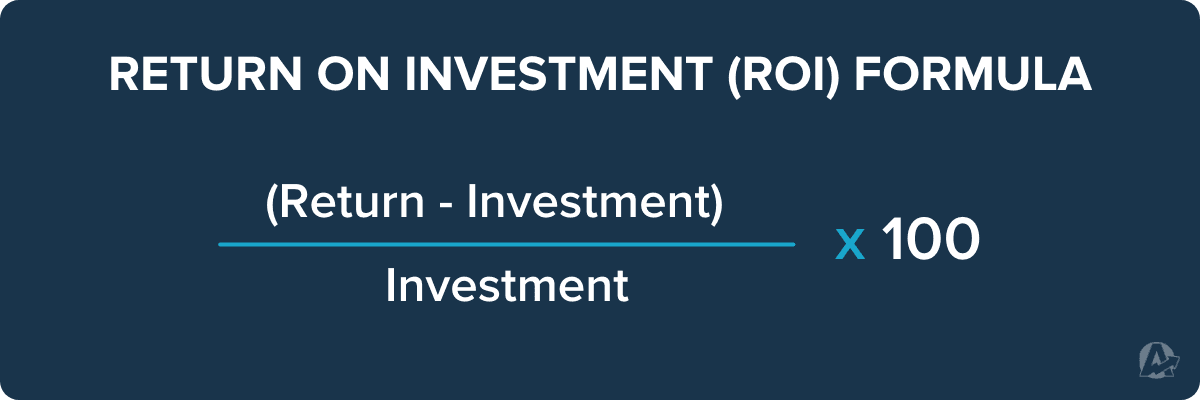
ROI is often measured according to attribution, either direct (last marketing touch before a sale) or indirect (attributed evenly across all touches). It should also include all the costs associated with marketing, including creative development, media spending, and customer-facing staff time.
New Visitor Conversion Rate
New visitor conversion rate hones in on the behavior of new traffic to your site, measuring the percentage of first-time visitors who make a purchase or complete the desired conversion activity. A high new visitor conversion rate indicates a website is successfully engaging and converting visitors into customers, while a low new visitor conversion rate hints that purchasing barriers should be smoothed out.
Returning Visitor Conversion Rate
The partner metric for new visitor conversion is the returning visitor conversion rate. This metric examines the conversion rate of repeat website visitors. Because of their previous exposure to the brand and demonstrated interest, a website's conversion rate for returning visitors should be higher than for new visitors, especially regarding purchases.
If for some reason the metric is as low as the new visitor rate, this signifies a problem with the sales funnel. Separating the two metrics gives your agency a more accurate understanding of the true conversion rate, especially since new visitors often skew the number downwards.
Average Time on Site
Another top metric to track is the average time on site, predominantly calculated by Google Analytics as the time between hits (or data requests on a website). How long a user stays active on a site, together with the conversion rate, indicates how quickly and efficiently people are converting.
A high conversion rate paired with a low average time on site means things are great and enough information is provided to convert users.
A high conversion rate and a high time on site mean that visitors are captivated, spending more than the usual amount of time engaging with content before converting, or that the decision to act requires more research.
If both are low, that’s bad news. Users are leaving immediately without converting and adjustments need to be made to keep users on the site.
Bounce Rate
To understand how well a website or app attracts and retains users, examine the bounce rate. This metric is the percentage of unengaged sessions that begin and end on the same page. An unengaged session lasts less than 10 seconds and doesn’t trigger a conversion event, meaning a user arrives on the page and then immediately exits the browser because they’re either uninterested or couldn’t find what they were looking for.
A good bounce rate is 40% or lower, while a rate of 60% or higher is a sign that you may need to evaluate site content to make it more engaging.
Order Confirmation
As the last stage of the ecommerce sales funnel, this conversion metric indicates how effectively customers are guided through their purchasing journey. A low order confirmation rate means there could be user experience or checkout problems.
Monitoring user flow through product description pages, payment and shipping information prior to order confirmation will reveal where customers are dropping off. This data can then be used for conversion rate optimization.
Revenue per Visitor
This metric calculates the average amount of revenue generated per site visitor over a selected timeframe. Revenue per visitor (RPV) is increased either by improving the sales conversion rate or by increasing the average purchase amount per customer. RPV is a straightforward way to measure how well sales growth and conversion efforts are working.

Cost per Acquisition
Cost per acquisition (CPA) is how much it costs to acquire a lead or customer. Distinct from customer acquisition costs, CPA focuses on acquisition costs per channel or campaign rather than the average cost across all channels. It’s calculated by taking the total advertising spend and dividing it by the number of generated acquisitions.
Not only is it a conversion metric, but it’s also a pricing model used by Google and others in online advertising. It’s preferred by some agencies because they determine their goal before launching a campaign and the client pays only when a conversion happens—like sales or form submissions. This may prevent overspending on irrelevant leads. Cost per acquisition is an important metric to determine advertising campaign efficiency and content engagement.
We were working on the campaigns of a service-based company and I noticed an average CPC almost equal to the daily budget we were running. From there, I looked at our target cost per acquisition and saw it was also very low for the industry. We performed a competitive analysis, pulled the top-of-page average bids, and presented a new budget recommendation to our client. They accepted the new budget, we adjusted our target cost per acquisition, and since making those adjustments, we've seen a 25.59% increase in our conversion rate and over a 300% increase in conversions.
Sara Kremm, Sr. Paid Media and Conversion Specialist, OTM
Average Order Value
Considered one of the most important metrics in ecommerce, average order value (AOV) examines the average amount spent by customers per transaction. It’s calculated by dividing total revenue by the number of orders. Because of the variability and competitiveness of online sales, AOV should be assessed monthly, or in some cases weekly to properly benchmark associated marketing spend and product pricing.

Selling more on each order is a great way to improve revenue without increasing marketing spend.
Cart Abandonment Rate
Today, on average two-thirds of all digital shopping carts are abandoned due to reasons ranging from user friction to site performance or simply window shopping. The cart abandonment rate metric helps marketers understand user behavior as it monitors the percentage of people adding items to their cart, but leaving the website or app without completing their transaction.
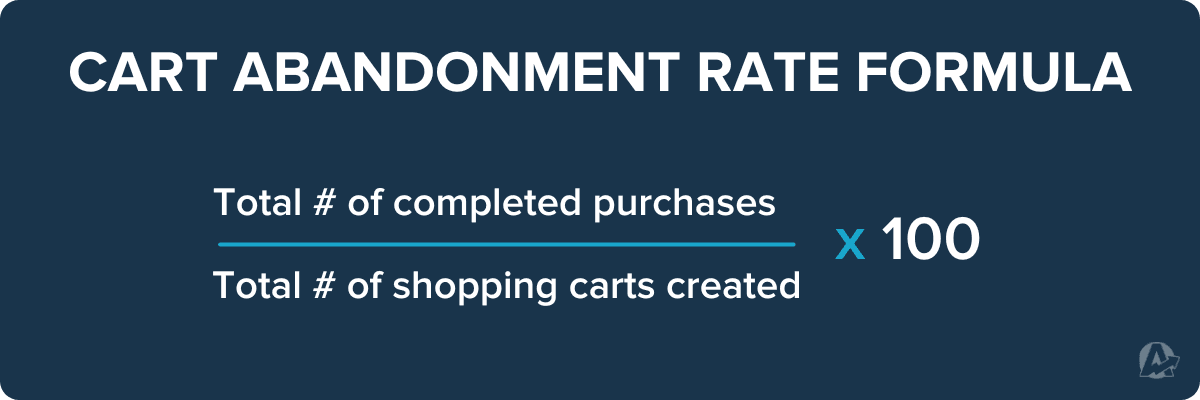
After determining the likely reason for cart abandonment, it’s possible to create solutions to drive up conversion rates, like average order value and order confirmation. A high rate of cart abandonment might indicate that resources are allocated towards inflated customer acquisition costs that fail to translate into actual purchases.
Conversion Data Analysis
As we’ve seen, there are a lot of different ways to calculate successful conversions, depending on activity, campaign and business objective. Effectively analyzing this data into a cohesive story with actionable recommendations is difficult without a way to harness metrics and insights.
Here are some techniques for interpreting conversion data to help your agency find the real underlying patterns and emerging trends.
Align With Clear Goals
The most important element of conversion rate analysis is determining whether it's currently trending towards hitting the client goals.
Bring your MASTER goals to life with goal tracking in AgencyAnalytics. Pass-fail visual flagging makes it easy for the agency and customers alike to see at a glance if conversion metrics are keeping up with targets. Conversion goals should be specific, measurable, time-bound, and most importantly, aligned with other key metrics like traffic, bounce rate, engagement, and revenue.

Identify Patterns and Trends
Once you've identified the key metrics for gauging your client's conversion funnel performance, track fluctuations over time. As your agency establishes a historical baseline, it’s easy to see spikes and dips in performance, and to identify which channels are trending upwards or falling off the map.
For example, let’s imagine your agency is tracking conversions generated from a social media ad campaign spanning Instagram, Facebook, and TikTok. Over time, you notice that the largest number of conversions are coming from TikTok, which makes sense given that your client’s target market primarily comprises Gen Z. As a result, you decide to pull back on spending on the Meta platforms in favor of more targeted content delivered on TikTok.
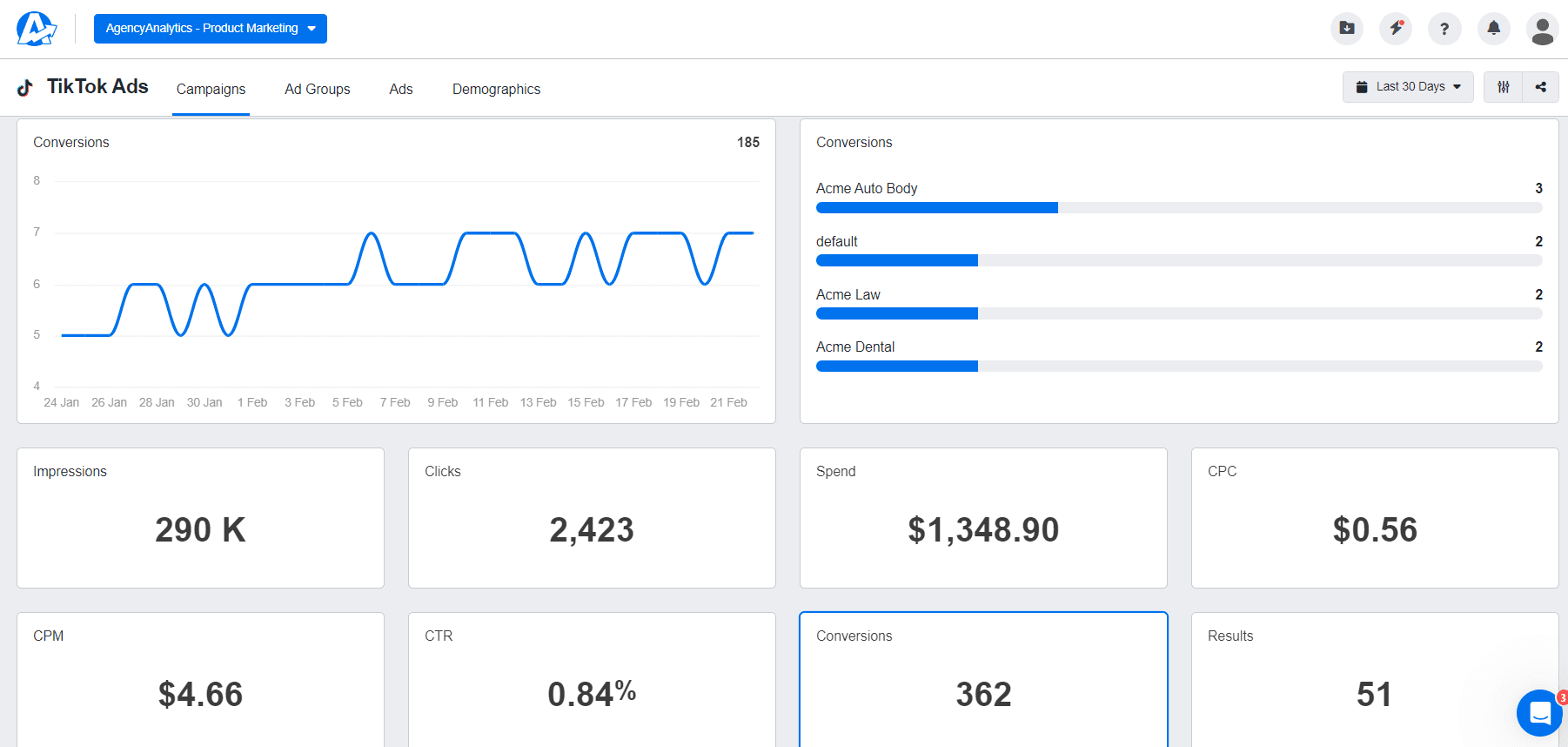
Join more than 6,500 marketing agency clients today and start building custom reports by signing up for a free 14-day trial with AgencyAnalytics.
Monitor Conversion Funnels Drop Offs
Monitor drop-off points in the conversion process to pinpoint areas needing optimization. For example, a PPC campaign might be doing a great job driving traffic to the client’s website. However, the bounce rate on the landing page is high, which is ultimately killing the conversion rate. Knowing where in the funnel the challenge is located enables your team to conduct A/B testing to improve the landing page design and CTA placement, ultimately increasing conversions.
AgencyAnalytics’ stacked charts are a great way to bring all of this data together into one easy-to-understand visual.

Best Practices for Client Reporting
Now that your agency has tracked and analyzed the conversion data, the final step is to report on progress to clients. The AgencyAnalytics Marketing Agency Benchmarks Survey revealed that the majority of agencies report to clients monthly, while others report weekly, quarterly, or daily.

While the cadence will be individually determined by the specific needs of your clients, there are several best practices that should be followed to ensure maximum effectiveness. Let’s take a look.
As businesses and consumers continue to increase reliance on digital platforms, costs for advertisers continue to rise. Rather than drain the bank accounts in the name of advertising, we are constantly looking for ways to improve conversion rates, reliance on SEO, and utilizing programmatic and social channels for lower cost engagement.
Adam Palmer, President, Inertia Digital Marketing
Visualize Data
Use data visualization tools to make conversion reports and dashboards more attractive and support clients in quickly grasping and interpreting KPIs. Data visualization reveals relationships between data points and uncovers patterns in large data sets that would otherwise go unnoticed in a spreadsheet. Clear and accurate charts and graphs simplify visual storytelling, facilitating quicker and more informed decision-making.

Automate Reporting
Empower clients with 24/7 access to their conversion dashboards and reports. Keeping clients engaged with campaign performance and motivated to make progress thanks to real-time reporting builds strong relationships and saves time by reducing follow-up calls and emails. Automate client reports in minutes with AgencyAnalytics to save hours of manual work each and every month.
White Label Reports
Quickly add your agency’s logo, branded color palette, and a custom URL to create a seamless reporting experience that looks like it was built in-house.
Templatize
Using templates for similar conversion reports or campaigns saves so much time and standardizes reporting across clients. Choose from AgencyAnalytics’ pre-built templates populated with common metrics, or create your own to better track custom insights and monitor trends.
Conversion Rate Optimization Strategies
To deliver consistent value and boost conversions, you’ll want to implement advanced conversion rate optimization (CRO) strategies. These include content enhancements, split testing and workflow improvements.
Once you’ve collected user feedback and other insights to determine what to test, run targeted A/B tests on CTAs, landing pages, and ads to see what resonates with users and drives higher conversion rates. The changes don’t always have to be big to make a difference! Sometimes just bumping a CTA above the fold, or slimming down the word count on a headline will make all the difference.
AgencyAnalytics’ cross-campaign reporting feature is a great CRO tool that brings together data from different campaigns or A/B tests. With everything in one place, conveniently monitor performance to identify optimization opportunities, and easily share these key insights with clients.
Summary and Key Takeaways
You’re not just throwing KPIs at the wall and seeing what sticks. Achieving strong conversion rate tracking and optimization of core conversion metrics is vital for agencies to demonstrate ROI and drive client success.
Take advantage of AgencyAnalytics’ automated dashboards and template builders to:
Automate reports and give clients unfettered access to keep them up-to-date and engaged with campaign progress.
Visualize conversion data with attractive, comprehensive graphs and charts to improve customer understanding and decision-making.
Bring together insights from campaigns or A/B tests for easy side-by-side comparisons.
Quickly build out templated, white-labeled reports complete with your agency branding for scalable reporting that wins back billable hours.
Track, report and analyze key conversion metrics now. Sign up for a free 14-day trial with AgencyAnalytics.

Written by
Lia Van Baalen is a Canadian content marketer with a decade of experience writing B2B content for SaaS, manufacturing and renewable energy companies. In her opinion, nothing is quite so satisfying in marketing as a good subject matter interview.
Get Started for Free


